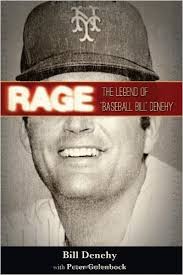

One of the most unusual trades in Mets history may also have been one of the most important. On November 27, 1967, the Mets traded rookie pitcher Bill Denehy and $100,000 to the Washington Senators for their manager, Gil Hodges. Gil was under contract to the second version of the Senators (the original Senators had moved to Minnesota and become the Twins in 1961, with the Nation’s Capitol getting an expansion team). It is not very common to see managers being traded. The trade of manager Chuck Tanner from the A’s to the Pirates for catcher Manny Sanguillen before the 1977 season comes to mind. What makes it interesting is that Gil had started his managerial career with the Senators in 1963 after getting traded from the Mets to Washington for the enigmatic centerfielder Jimmy Piersall. Gil had been the opening day first baseman for the Mets in 1962, but after a season and a half of injury plagued play, it was pretty much time for the great Dodger slugger to retire.
Hodges had been successful with the Senators, improving their record each season he managed. But the great man from Indiana had made his permanent home in Brooklyn and the offer to manage the Mets was too much to pass up. On the Mets side of the equation, they were in the market for a manager after skipper Wes Westrum suddenly resigned with 11 games left to play in the 1967 season, being replaced on an interim basis by one of the greatest names in baseball history Salty Parker.
Bill Denehy turned 18 on the day I was born, March 31, 1964. It was also just a few days before Shea Stadium opened its turnstiles for the first time. Denehy was a big kid out of Middletown, Connecticut, and the Mets scouted and signed the righty straight out of high school. His best weapon was a fastball that topped out at 97 MPH, although like many young hard throwers, Bill was wild. After 3 seasons in the minors, Bill made the club out of Spring Training and made his Major League debut on April 16 in Philadelphia. Although he took the loss, Denehy pitched well going 6 and a third while only giving up 3 hits, 2 earned runs and 6 walks while striking out 8 Phillies. It was a good start, but the results would remain the same for a Mets club that finished in the cellar again. Denehy’s lone victory was on May 28 at Shea against the Braves, but he finished the season on June 25 when he was sent back to AAA. He had injured his arm earlier in the season throwing a slider to Willie Mays. He would never be the same pitcher after that pitch. His final pitching line was 1-7, 4.70 ERA, 53.2 innings pitched, 51 hits, 28 earned runs, 29 walks, 35 strike outs and 8 homers.
His results were not much better in Washington in 1968, where he only pitched in 3 games. He was traded to Cleveland in 1969 for journeyman outfielder Lee Maye, but wasn’t called up to the majors. The Mets got him back in the minor league draft in November 1969, but never called him up either. Denehy was eventually traded to the Tigers with veteran starter Dean Chance before the start of the 1971 season. He pitched in 31 games for the second place Tigers that year, but that would prove to be Bill Denehy’s last time in a major league uniform. Like so many other prospects, his career was over at 25, cut short by injury and inconsistency. A series of questionable cortisone shots administered to fix his arm would eventually cost Bill Denehy his eyesight.
Bill Denehy would go on to be the pitching coach for three seasons for the New Britain Red Sox and would coach collegiate baseball at Hartford for a few seasons. However his temperament and issues with substance abuse cost him his job at Hartford. But today, Denehy is putting his life back together through rehab and also by writing his autobiography Rage, with famed writer Peter Golenbock. We here at the Daily Stache wish Bill Denehy continued success with his recovery. As for Gil Hodges, we all know how that would lead to a Championship in 1969, but a sad and tragic end in 1972, when Gil would die of a massive heart attack on the last day of Spring Training.
Today, Bill Denehy is remembered for another reason. He appears on one of the most valuable baseball cards to Met fans, 1967 Topps Card 581: Mets Rookie Stars. He shares with someone by the name of George Thomas Seaver.
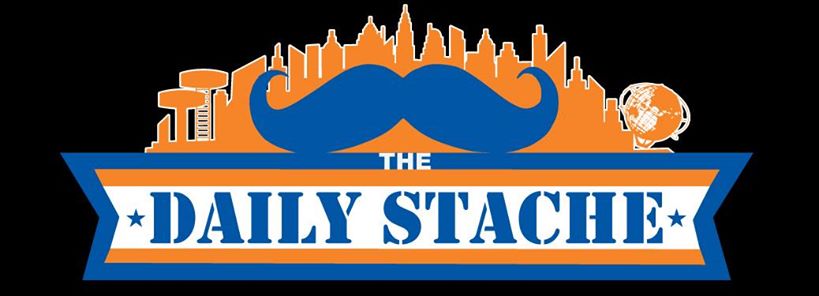
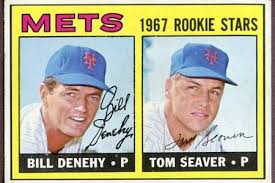
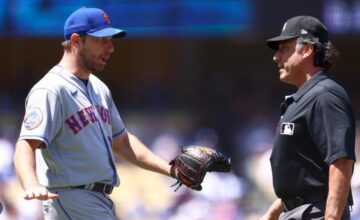

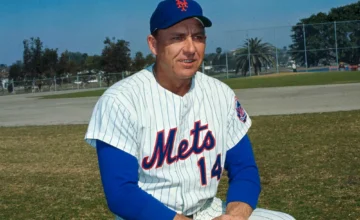
2 Comments